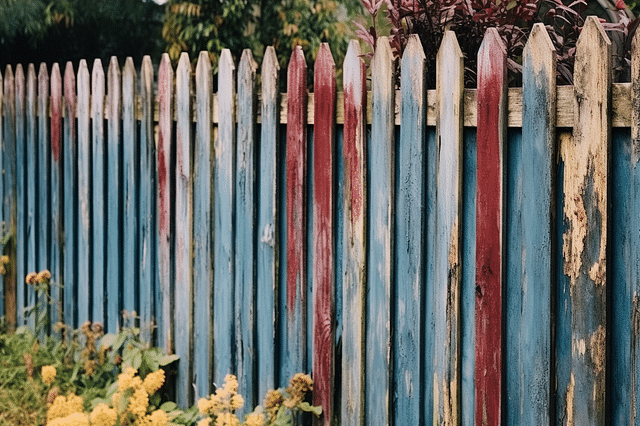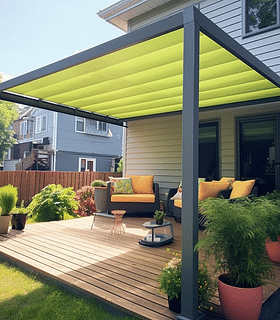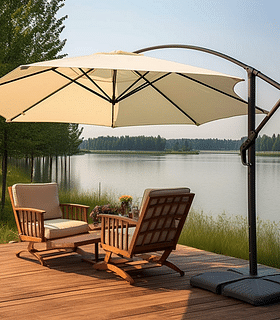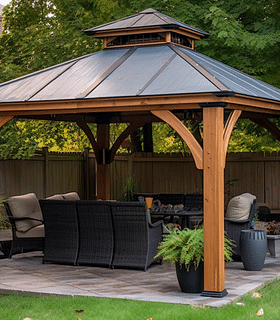Update Your Fence: Paint vs. Stain - Pros and Cons Explained
Paint or stain? Discover the pros and cons of updating your fence. Make an informed decision with our in-depth analysis.

Have you ever looked at your fence and felt like it's time for an update? Maybe the paint is starting to peel or the stain is fading away. The good news is, you have options to bring your fence back to life and enhance its appearance. In this blog post, we will explore the pros and cons of two popular choices: painting and staining. By the end, you'll have a clear understanding of which option is best for your fence and how to achieve a stunning final result. So, let's dive in and discover whether painting or staining is the right choice for updating your fence!
Why Updating Your Fence is Important
Over time, your fence is exposed to various weather conditions and daily wear and tear. This can lead to a range of issues such as fading, rotting, rusting, and even structural damage. By regularly updating your fence, you can address these issues and extend the lifespan of your fence.
Updating your fence also has aesthetic benefits. A fresh coat of paint or stain can instantly transform the appearance of your fence, giving your outdoor space a refreshed and polished look. It can also increase the curb appeal of your property, which can be especially important if you are looking to sell your home.
Furthermore, updating your fence can improve its functionality and security. A sturdy, well-maintained fence can provide privacy, keep unwanted animals out of your yard, and create a safe area for children and pets to play.
Understanding the Difference between Paint and Stain
When it comes to updating your fence, you have the option of using either paint or stain. Understanding the difference between the two can help you make an informed decision based on your specific needs and preferences.
Paint is a protective coating that creates a solid, opaque finish on the surface of the fence. It comes in a wide range of colors and can completely change the look of your fence. Paint provides excellent protection against moisture, UV rays, and other elements, which can help prolong the life of your fence. However, it does require regular maintenance and may eventually chip or peel, necessitating touch-ups or a complete repaint.
On the other hand, stain is a transparent, semi-transparent, or solid color solution that penetrates the wood fibers of your fence. It enhances the natural beauty of the wood and adds a layer of protection against moisture, UV rays, and mildew. Stain allows the texture and grain of the wood to show through, providing a more natural look. It is generally easier to apply and requires less maintenance compared to paint. However, the color options may be more limited.
Ultimately, the choice between paint and stain depends on your personal preference, the current condition of your fence, and the desired look you want to achieve. Consider factors such as durability, maintenance requirements, and the aesthetic appeal when making your decision.
In the next sections, we will provide step-by-step instructions on how to update your fence with paint or stain. So, let's get started on transforming and rejuvenating your fence!
Pros and Cons of Painting Your Fence
Painting your fence can have both advantages and disadvantages. It's important to weigh the pros and cons before making a decision. Let's take a closer look at each.
Pros of Painting Your Fence
Enhanced Aesthetics: One of the primary benefits of painting your fence is the improvement in its appearance. A fresh coat of paint can transform a worn-out, dull fence into a vibrant and appealing feature of your outdoor space. It allows you to customize the color and style to complement your home's exterior.
Protection from the Elements: By painting your fence, you provide an extra layer of protection from weather elements such as sunlight, rain, and snow. This added barrier helps to prevent damage, such as wood rot, warping, or discoloration, which can extend the lifespan of your fence.
Increased Durability: A coat of paint reinforces the strength and durability of your fence by forming a protective barrier against moisture, insects, and other potential damages. It helps to minimize the risk of splintering, cracking, or decay, making your fence more resilient over time.
Easy Maintenance: Painted fences are generally easier to clean and maintain compared to unpainted ones. The paint creates a smooth, washable surface that allows you to easily remove dirt, dust, or any other stains with little effort. It also helps to resist mold and mildew growth, reducing the need for frequent cleaning.
Customization Options: Painting your fence gives you the opportunity to express your personal style and create a cohesive look for your outdoor space. Whether you prefer a classic white picket fence or a bold, statement color, painting allows you to customize your fence to match your overall design aesthetic.
Cons of Painting Your Fence
Maintenance Requirements: While painting can offer protection, it also requires ongoing maintenance to keep it looking its best. Over time, the paint may chip, fade, or peel, necessitating touch-ups or a complete repainting. It's important to consider the time, effort, and cost involved in maintaining a painted fence.
Limited Natural Wood Look: If you have a wooden fence with a beautiful natural grain, painting it will obscure the wood's natural beauty. Some people prefer the rustic charm and authenticity of a natural wood fence and may find painting to be a disadvantage.
Longevity and Weather Resistance: While painting your fence can provide some protection against the elements, it may not be as durable or weather-resistant as other fence treatments like staining or sealing. Depending on your climate and the quality of the paint used, you may need to repaint more frequently to maintain its appearance and protection.
Cost Considerations: Painting your fence can be a significant investment, especially if you have a large or intricate fence design. The cost of paint, equipment, and labor can add up quickly. It's essential to factor in your budget and future expenses when deciding whether to paint your fence.
Potential Health and Environmental Effects: Some paints may contain harmful chemicals that can pose health risks if not handled or disposed of properly. If you have children or pets that frequently come into contact with the fence, it's important to choose non-toxic paint options and follow appropriate safety measures.
Consider these pros and cons carefully to make an informed decision about whether painting your fence is the right choice for you. weigh the benefits against the potential drawbacks and prioritize what matters most for your specific circumstances.
Pros and Cons of Staining Your Fence
Staining your fence can bring both advantages and disadvantages. In this section, we will explore the pros and cons of staining your fence to help you make an informed decision.
Pros of Staining Your Fence
Staining your fence can offer several benefits:
Enhanced Appearance: One of the biggest advantages of staining your fence is that it enhances its visual appeal. With a wide range of stain colors available, you can choose one that complements your home's exterior and adds a touch of elegance to your outdoor space.
Protection from the Elements: Staining your fence creates a protective barrier that helps shield the wood from the damaging effects of the sun, rain, snow, and other weather elements. By preventing moisture from seeping into the wood, staining can help prevent rotting, warping, and cracking of the fence.
Increased Durability: Stain can penetrate deeply into the wood fibers, reinforcing them and making the fence more resistant to wear and tear. This can extend the lifespan of your fence, saving you money on repairs or replacements in the long run.
Resistance to Pest Infestations: Some stains contain additives that repel common pests, such as termites and carpenter bees, keeping your fence protected from damage caused by these intruders.
Cons of Staining Your Fence
While staining your fence has numerous benefits, it's important to consider the potential drawbacks:
Initial Time and Cost: Staining your fence can require a significant investment of time and money. You'll need to properly prepare the surface, apply the stain carefully, and allow sufficient drying time. Additionally, purchasing high-quality stain products and tools can add to the overall cost.
Regular Maintenance: Although stain helps protect your fence, it is not a permanent solution. Over time, the stain will fade and wear off, requiring reapplication every few years to maintain its effectiveness. This ongoing maintenance can be time-consuming and may add to your long-term expenses.
Limited Color Choices: Unlike painting, stain offers a more limited range of color options. While this may not be a concern for some, those looking for a wider variety of colors to match their aesthetic preferences may feel restricted in their choices.
Potential for Uneven Results: Achieving a consistent and uniform appearance when staining a fence can be challenging. Uneven application, brush marks, or issues with the wood surface can all contribute to an imperfect finish.
By weighing the pros and cons of staining your fence, you can make an informed decision about whether it's the right choice for you. Factors such as your budget, maintenance capabilities, and desired aesthetic outcome should all be considered before proceeding with this project.
Factors to Consider Before Making a Decision
When it comes to making a decision about installing a new fence, there are several factors you need to consider. By taking the time to think through these factors, you can ensure that you choose the right fence for your needs. In this section, we will discuss four key factors that you should keep in mind.
Fence Material and Condition
The first factor to consider is the material and condition of the fence. Different materials have different strengths and weaknesses, so it's important to choose one that suits your needs. For example, if you value privacy, you might opt for a solid wood or vinyl fence. On the other hand, if you prefer an open and airy feel, you may lean towards a metal or chain-link fence.
Additionally, it's crucial to assess the condition of any existing fences on your property. If your current fence is in disrepair or has reached the end of its lifespan, it may be more cost-effective to replace it entirely rather than investing in repairs.
Desired Aesthetic and Style
Another important factor to consider is the desired aesthetic and style of your fence. Your fence will be a prominent feature of your property and can greatly impact its overall appearance. Consider the architectural style of your home and the surrounding landscape when choosing a fence style.
You may also want to think about the color of the fence and how it will blend in with the rest of your property. Some homeowners prefer their fence to be a focal point, while others may want it to seamlessly blend in with the surroundings.
Maintenance Requirements
Different fence materials have varying maintenance requirements. Some materials, like aluminum and vinyl, are low-maintenance and only require occasional cleaning. Others, such as wood, may need regular staining or sealing to maintain their appearance and protect them from the elements.
Consider how much time and effort you are willing to invest in maintaining your fence. If you have a busy schedule or would rather spend your weekends doing something other than fence upkeep, it's worth opting for a low-maintenance material.
Long-Term Cost Considerations
Finally, it's essential to think about the long-term costs associated with your fence choice. While upfront costs may be a significant factor, it's also important to consider the cost of maintenance, repairs, and potential replacement.
Some materials may have a higher upfront cost but require minimal maintenance and can last for decades. On the other hand, lower-cost materials may require more frequent repairs or replacement, which can add up over time.
By carefully considering these long-term cost considerations, you can make a decision that not only fits your budget but also provides the best value for your investment.
Take the time to consider these factors and weigh your options before making a final decision. By doing so, you can ensure that you choose a fence that meets your needs in terms of material, style, maintenance, and long-term cost.
Making an Informed Decision
When it comes to making an informed decision, it's crucial to gather all the necessary information and evaluate it carefully. Consider the pros and cons of each option, weigh the potential risks and benefits, and consider how each choice aligns with your goals and values. Don't rush the decision-making process; take your time to gather insights and perspectives from trusted sources.
Additionally, it's essential to consider any potential long-term implications of your decision. Ask yourself how each choice may impact your future and whether it aligns with your overall aspirations. Remember, making an informed decision requires a holistic understanding of the topic, so be sure to explore different viewpoints and gather as much information as possible.
Final Thoughts
Making a decision can be challenging, but armed with the right information, you can feel confident in your choices. Trust your instincts and rely on the knowledge you have gained throughout your research. Remember that even if a decision doesn't turn out as expected, it's an opportunity to learn and grow. Embrace the journey and trust that you have made the best decision with the information you had at hand. Happy decision-making!
Trending products
Shop outdoor accessoriesFrequently asked questions
- Is it better to paint or stain my fence?
- Both painting and staining have their pros and cons. Painting provides a wide range of color options and offers better protection against the elements, while staining allows the natural beauty of the wood to shine through and provides easier maintenance. Consider your personal preferences and priorities when deciding which option to choose.
- Does paint or stain last longer on a fence?
- Generally, stain tends to last longer on a fence compared to paint. Stain penetrates the wood, providing a deeper level of protection, while paint sits on top of the wood and may peel or chip over time. However, the longevity of either option depends on factors such as the quality of the product and the level of maintenance.
- Can I change the color of my fence with stain?
- Yes, you can change the color of your fence with stain. Stain comes in a variety of shades, from natural wood tones to darker hues. If you're looking for a drastic color change, stain may not be the best option as it enhances the existing color of the wood. However, it can be a great choice if you want to enhance or deepen the natural color.
- Does paint or stain require more maintenance?
- Paint generally requires more maintenance than stain. Over time, painted fences may start to peel or chip, requiring touch-ups or full repainting. Stain, on the other hand, tends to fade gradually and can be easily revived with a fresh coat without the need for extensive prep work.
- Can I paint or stain a previously painted fence?
- Yes, you can paint or stain a previously painted fence. However, it's important to properly prepare the surface by cleaning, sanding, and removing any loose paint or debris before applying a new coat of paint or stain. This will ensure better adhesion and a longer-lasting finish.
- Can I use paint or stain on a new fence?
- Yes, you can use either paint or stain on a new fence. However, it's recommended to wait for the wood to cure and dry properly before applying any finish. This usually takes a few months, depending on the type of wood. Be sure to check the manufacturer's guidelines for specific recommendations.
- Will paint or stain protect my fence from weather damage?
- Both paint and stain offer protection against weather damage. Paint forms a protective barrier on the surface, shielding it from moisture and UV rays. Stain, on the other hand, penetrates the wood, providing protection from within while allowing the wood to breathe. Consider the climate in your area and the level of exposure your fence receives when choosing your finish.
- Can I apply paint or stain myself, or should I hire a professional?
- You can apply paint or stain to your fence yourself, as long as you follow proper application techniques and use the right tools. However, if you're unsure or uncomfortable with the process, hiring a professional can ensure a high-quality and long-lasting finish.
- Which option is more environmentally friendly: paint or stain?
- Stain is generally considered more environmentally friendly than paint. Many stains are water-based, contain fewer harmful chemicals, and have lower volatile organic compound (VOC) levels. However, it's important to choose a stain that is labeled as environmentally friendly or low VOC to minimize any negative impact.
- Can I remove paint or stain from my fence if I change my mind?
- Yes, you can remove paint or stain from your fence if you change your mind. However, removing paint usually requires more effort and potentially harsh chemicals compared to removing stain, which can often be stripped off with a power washer or chemical stripper. Consider the effort and cost involved before making your decision.
Are you looking for more ideas?
Have a look at these other guides about improving your garden and patio to create your dream outdoor space!

Are you looking for more ideas?
-
- Role
- How to stretch chain link fence for maximum durability
- Description
- Discover the ultimate guide to stretching chain link fences for maximum durability. Enhance the functionality and appeal of your property with our expert tips. Don't miss out on our valuable updates!
-
- Role
- How to cut a chain link fence with ease
- Description
- Looking to cut a chain link fence effortlessly? This blog post has all the tips and tricks you need. Don't miss out, read on now!
-
- Role
- How to Fix Sagging Patio Chairs - Quick and Easy Solutions
- Description
- Fix your sagging patio chairs with these quick and easy solutions. Bring new life and comfort to your outdoor space. Explore our step-by-step guide now!
-
- Role
- How long does a cedar fence last? - Tips for increasing its lifespan
- Description
- Increase the lifespan of your cedar fence with these expert tips! Find out how long a cedar fence can last and get the lowdown in our latest blog post. Don't miss out, read on now!



